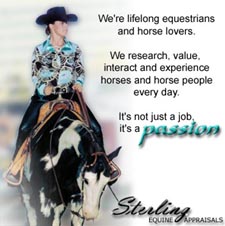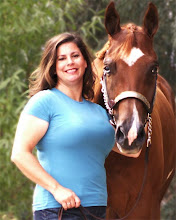Recently, I posted Part I, with the answers I give to the most frequently asked questions from those considering becoming an equine appraiser. If you love and are knowledgable about horses, are well written, well spoken, and willing to run a professional business, being an equine appraiser may be a lot of fun for you.
As promised, this is about a "day in the life" of an equine appraiser. I am a lifetime certified equine appraiser and have been studying horse values for over a decade. I thought those interested in the profession might find value in a typical day.
Recently, I appraised a 10 year old Warmblood gelding that had been donated to a non-profit. We'll call him "Casey."
Monday 5:30 AM - 6:30 AM
For the first hour, I review emails and return inquiries. If the inquiry comes from the East coast, which is three hours ahead, now is the perfect time to return phone calls. Otherwise, I will respond via email. Lastly, I take one last look at all the submitted materials about "Casey," his ownership and vet history, his show record and training experiences, to be most prepared to see him in person later today.
I also make a plan about the rest of the day. Do I have fresh batteries in the camera? Is the video camera charged? Are my business cards and brochures stocked? Who else do I need to follow up with?
Monday 6:30 - 10 AM
I drive to the on-site inspection.
I make good use of the travel time following up on other appraisal projects. I had three in the works on this particular day, so I made calls to an attorney, a performance horse association, and a veterinarian, to request various records or ask questions about their client's horses. Of course, I am doing this hands-free and asking them to fax or email their responses, so I am not trying to take notes. I may pull over and jot down a lead or tip (like the name of a prior owner not listed on a horse's registration certificate) so I can follow up on it when I am back in the office.
During the drive, I mentally prepare for the questions I need to ask and how I will handle any unique circumstances, like a facility without a suitable riding arena. I have had the benefit of seeing several show videos of Casey, so I have an opinion about what kind of horse he is before I even get out of the car.
Monday 10:00 AM - 11:00 AM
Being professional means being on time; I never want to have my clients waiting for me. I arrive at the non-profit facility a few minutes early. I get my paperwork out, make sure I have everything I need on my clip board, and walk to the barn. I introduce myself, and hand my business card to the trainer. She will be assisting me during the on-site inspection.
10:00 - 10:20
I watch Casey be led out of his stall to the grooming area. I observe his walk for the footfall, and also begin to assess his conformation. This is a lot like judging Halter, but I am evaluating Casey's build against the Warmblood breed standards and against the most appropriate structures to perform his particular discipline, which is jumping.
My first impression is that Casey is a handsome horse that looks like he's always had a job - there are some lumps and bumps on his legs, but he's in great physical condition and has very good eye-appeal. A potential buyer would like him! During this time, I am making notes about Casey's build, and mentally keeping track of things that I want to observe when he moves (at liberty and under saddle). For instance, Casey toes out slightly, so I would like to see if that translates into winging or paddling when he moves.
I also observe his attitude and manners. Does he stand tied? Are there any places on his body that he reacts to while being groomed or tacked up? Would a novice feel comfortable and be safe handling this horse? Not every horse is beginner friendly, and the market for "experienced handlers" is considerably smaller than the one for horses that anyone can handle.
After my initial review, the trainer takes Casey out to a level, grassy area. I keep watching his movement and attitude. Then she poses him for pictures. In addition to validating my impressions about his conformation, the pictures document the specific horse I saw. This helps to confirm registration, reported markings, brands, and other unique characteristics.
This is a very detail oriented job.
10:20 - 10:35
Casey is taken to the arena. Being an appraiser, I am an observer. I stand back and watch a lot. First, I want to make sure he is servicably sound and to examine the quality of his movement. Then I am looking to see how adjustable, broke and easy to ride Casey is. This helps me identify the type of buyer for which he would be most suitable. And, that helps me determine his place in the overall show horse market.
The trainer works Casey at the walk, trot and canter, around the ring and across the diagonals. I don't want to interfere, but I also have certain things that I need to see. I ask to see some equitation test elements like halt and reinback, counter canter, and sitting and extended trots. She shows me a few flying changes, too.
Overall, Casey seems happy and quiet in his work. He's actually much softer and more quiet than I expected from the show videos. He seems a little bracey in his jaw and doesn't want to flex at the poll. I consider the tack and ask the trainer about the bit. I also explain what I observe and ask for her feedback to help develop my opinions.
10:35 - 10:50
Now that Casey is warmed up, the trainer is ready to jump him. We set a few fences. I take a couple of photos and a little video during this portion so I can make sure what I think I see as his jumping style is really his true form. The way a horse jumps is an indication of athletic ability, training, and suitability to the various divisions. In very basic terms, a Hunter should be round, a Jumper should be efficient, an Equitation horse will probably jump a little flat and be pretty adjustable.
We build up to a few lines, an oxer, a vertical. Casey is happy to jump, and gets the distances (even though the arena is small and I set one line a little long). He needs a little help balancing in the corner, so I know he's not a rank beginner's horse. His jumping form is efficient, though not especially stylish, comfirming that the Jumper division is a really good fit for him.
10:50 - 11:00
Casey walks a few rounds to cool out and then we head back to the grooming area. I continue to observe him. Is he taking the same steps now that he did before working out? Yup! No issues with work. Is he well behaved to be unsaddled? How does his back look? I ask a few more questions about his daily care, feeding and routines. I think I now have a clearer picture of Casey. After a few more notes, I thank the trainer and staff, then leave the facility.
Monday 11:00 - 2:00 PM
I start driving back to the office. I call one of the other appraisers in my firm and ask her to get USEF records for Casey. I provide the USEF number and ownership details that I got during my discussions with the trainer this morning. I share my observations of Casey and ask her to start pulling sales comparables. It's great to have partners!
Monday 3:00 - 5:00 PM
After a on-the-road lunch, I am back in the office. With all this new data, photos, and video, I need to get it on the computer for safe keeping. While the on-site inspection takes about an hour, it is just the tip of the appraisal iceburg. I did research before the on-site and still have a great deal of research to do now. Throughout the data transfer process, I am making notes and capturing my observations, opinions, and next steps.
I make a few phone calls to get vet records on Casey. It usually takes about 24 hours from the time we request information until we receive it, so fact gathering for the appraisal stretches out over several days.
And, I have received some of the information I requested on other projects. I get that organized, make sure I know where things were filed that came in while I was on the road, and follow up on any emails or phone calls that require my personal attention. At 5 PM, I am wrapping up a very successful and productive day.
I hope this provides a glimpse into the multi-tasking job of being an equine appraiser. Good luck to all those who try it.


